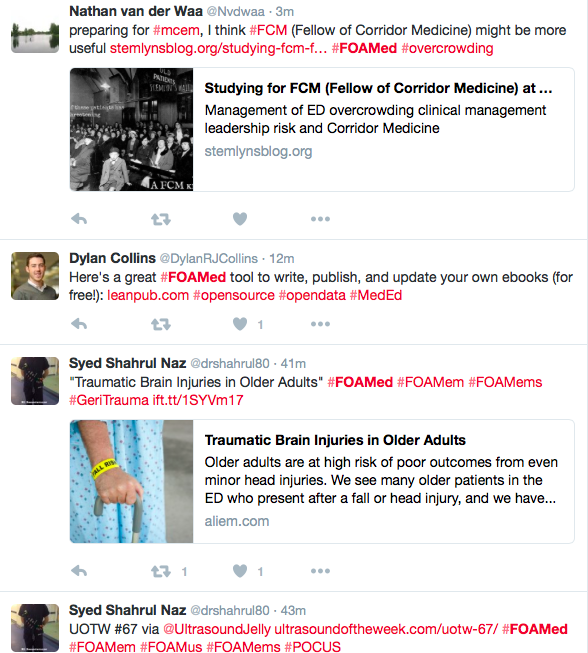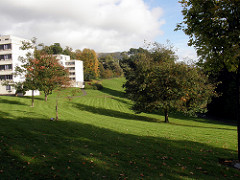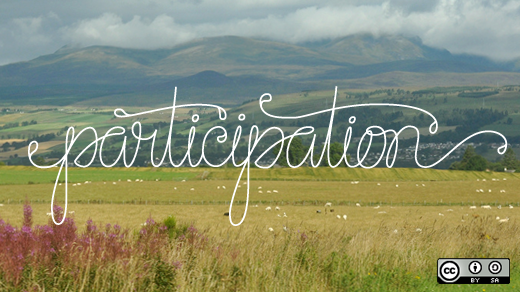Natalie Lafferty is Head of the Centre for Technology and Innovation in Learning at the University of Dundee, Scotland. Prior to taking up this post in December 2014 Natalie held an e-learning role as a lecturer at the Medical School. Natalie has been encouraging OER developments at Dundee, beginning her journey to becoming “an advocate of OER” with her involvement and sharing of “reuseable learning objects” as part of the international virtual medical school (IVIMEDS) project whilst working at the Centre for Medical Education at Dundee.
The Dundee Story
The University of Dundee has had ongoing involvement in open education; from early involvement in the JORUM repository to more recent involvement in the MOOC platform FutureLearn. One Dundee University MOOC Anti-microbial Stewardship: Managing Antibiotic Resistance encapsulates the idea of openness as accessibility for Natalie: the MOOC enabled participants from around the world to share experiences whilst engaging with and accessing openly licensed contemporary research and practice guidance on an important challenge for medics across the world. The MOOC’s impact was far reaching and this encapsulates openness for Natalie as it is “…a public good at the end of the day and I think ultimately it can improve outcomes for people in their day to day lives.”
Initial use of OER at Dundee Medical School focused on identifying and sharing suitable OER for busy doctors to use to help “support” teaching carried out in addition to their everyday clinician role. As Natalie explained:
“I came into that [my current] post being an advocate of OER and thinking how can we make use of it and highlight that there was OER available. And that was kind of relatively easy, when staff could see that there was good content on YouTube that they could reuse…”
In tandem with this the Medical School also began to use WordPress alongside their VLE, Blackboard with a number of lecturers experimenting with it to support teaching and learning. WordPress went on to be piloted as an alternative to Blackboard in the respiratory medicine block and compared with using Blackboard for endocrinology teaching. Students found WordPress to be a much more positive experience and accessed more teaching resources than in Blackboard. Further encouraging feedback from students and increasing staff engagement led, the Medical School to adopt Wordpress as a VLE for the undergraduate curriculum. Whilst “it was the usability…” of Wordpress which was central to the case for adopting Wordpress as the Medical School’s VLE there was also a “sustained level of student engagement” in use of the platform during the review period with some students wanting to develop learning resources and the VLE as part of the “student selected components” part of their course.
More recently the WordPress VLE has been further developed to introduce more “consistency” in its look and feel and to support “curriculum mapping” of learning resources and activities to the General Medical Council (GMC) outcomes framework helping to make the VLE easier to search and less “Wild West” and ad hoc. The VLE is also now closed, due to patient related content, whereas it was originally open when first launched. However, where possible, content is made openly available.
“If we’re using OERs from other people, we need to be giving back. I think that’s what OER is all about.”
Student created OER
Student enthusiasm for creating and reviewing online content as part of their course was supported and encouraged and also led to an interest from clinicians in creating their own OER. However, in some cases the resources being created were not always suitable for release online as some students and medics lacked the skills for creating resources that could be used successfully online. Copyright, accessibility and pedagogical issues were frequently identified in material submitted for inclusion on the VLE. Whilst ad hoc face-to-face training sessions with interested students and medics carried out by Natalie and her team helped support people in the short-term, a longer-term strategy was needed.
One solution came via an Higher Education Authority (HEA) project focused on “working with students as partners in the curriculum” and from this Natalie and her team developed OER on copyright, managing projects and “…the teacher as curator…” These OER helped both students and their tutors:
“…to understand better what’s involved in developing an online educational resource but also trying to get over to them that if they were developing something that really we would like them to develop it as an OER so that it could then be shared and then they would have something to put on their CVs, and have a metrics in a sense.”
In addition to improving student and educator digital literacy, it was important that people could showcase what they had (co-)created whilst having evidence for any impact of the materials.
The Impact of Open
Natalie reported that students favoured the new approach, as the “legacy” of the OER they created was greater than that of a conventional project essay, which was usually read by a limited audience. The impacts and benefits of Dundee’s open approach were encapsulated by two examples:
“…It was a fifth year student, preparing their application for their foundation post and they’d been involved in the early days of these students developing OERs and they’d developed a whole series of podcasts and YouTube videos. And he just obviously had not looked at it for about a year or so and he said ‘we’ve had 10,000 hits’. And he said ‘I can’t believe this!’ and it was that kind of look of thinking that what he’d done people had valued and the comments were positive because they focused on things that they found difficult to learn. So it’s that thing that actually what they developed was so useful to other medical students.”
Similarly:
“And I’ve also had students who have been applying for their core training posts. So we had a group of students who developed a series of anatomy tutorials … and they developed these resources and they’d been used by students in the curricula and then when they went for their core training posts they said ‘can I share the links to these?’ and I said ‘yes, you can because they’re open links.’ And then when they had their interview that was the focus of quite a bit of the interview. So again it was the fact that work they’d did was of value for their future career and they’d learnt skills… because when it comes to when you’ve had involvement of training and teaching people want to see the evidence and the students who’ve developed OER have that evidence and they’ve also got the feedback of how it’s been used and how it’s helped student learning.”
Designing for online learning
“People would come in and we would say: ‘actually why do you want to do this online? Why do you want to use technology? You don’t need to. Just design the activity like this.’ And sometimes we have developed online learning resources and at the end of it I’ve said to the lecturer ‘what does that do that this diagram didn’t do?’ So there’s a sense in which, by working with them, and taking this approach it’s informally supported staff development in a sense because people begin to understand why you use technology…”
Natalie emphasised the need to think carefully about whether online delivery course content was appropriate and if so, to design for online at the outset. Providing training, materials and tools so that people can do so effectively is critical:
“I do have issues with the way we use technology. I’m concerned that we use it just to spoon feed students rather than really designing leaning activities, which help them to understand how to use the technology and to develop the skills to be self-regulated learners, self-directed learners. And I think that’s because – it’s like Powerpoint is the most widely used educational technology but it’s also the worst – it’s about how can we encourage the teachers to think about their learning activities, how they design these, and has technology got a role. So I’d like to get away just using basic tools to some more nitty gritty that’s really going to help our teachers.
But also I think to help students because I think increasingly people looking at workplace learning – and there’s been so much click-click-click e-learning developed which really doesn’t bring about behaviour change and more and more people are recognising that actually it’s about using social learning in the workplace, communities of practice and that those people who do well in that are those who do have those skills in self-regulated learning. And with things changing so rapidly our graduates need to develop those skills.”
Opportunities to introduce open badges are being explored at Dundee to help students “evidence” and show that they have developed particular skills or knowledge. They can be helpful for graduates to demonstrate competencies to future employers. For medics in training, who will need to teach as part of their future careers, they could be awarded to credit students’ teaching skills. Moving forward there is perhaps an opportunity to map competency frameworks from organisations such as the HEA and GMC to their badges to ensure that students are developing relevant competencies and skills.
Natalie had this advice for involving students in the development of OER:
“…to really make sure that you have in place a programme that’s going to help them understand… – if they’re just doing video, it’s a simpler kind of level so we do have students who as part of the course they’re asked to develop as a team a five minute video with some assessment attached to that – and so there the advice the advice is around what tools they might use, free editing tools, all that kind of stuff. So we do have a little guide, getting started with developing students as producers of learning, which we share with people.
And then I think that if you’re going to involve students in developing more sophisticated online learning, so if they’re developing interactive tutorials – which are more a simulation of a patient journey – then it’s about looking at learning design, educational theory. This is where you need to really have some resources in place, or a pathway where you signpost students to resources. So they begin to understand about copyright and where they can find copyright free images or CC images. Encourage them to create their own images, their own drawings (which are what some of our students are now doing). It’s also then about the usability, the accessibility stuff but also getting them to understand about some basic educational theory so they’ve got an understanding of that when they’re designing their learning resource. It’s also if they’re designing something that’s a formative assessment, or a self-assessment type of activity or resource, the importance of good feedback. All that sort of thing. So in a sense they’re developing the resource but they’re learning the essential skills for being a teacher and designing learning activities and particularly designing learning online, and aware of some of the issues they need to think about.”
Using Twitter for Teaching
Effective use of social media in teaching is critical and Natalie spoke at length about how her own use of Twitter helped inform the way in which she encouraged students to engage with the platform:
“And I think it’s partly because of how we, we think – oh! Let’s use Twitter in the classroom – without really thinking about how we use it as professionals. And as professionals we use it as a networking tool and that’s where my learning network is. I pose a question and I learn so much from people. And students have their Facebook groups but they don’t look more widely.
So it’s interesting when I’ve looked at Twitter more recently what I’ve tried to do is to say: Twitter is a place to filter and search for OER that’s validated by professionals.
And I did a teaching session recently with some medical students who are doing a BMsC in Teaching in Medicine and I said I want you to look up this hashtag #FOAMed and see what you see. And it was like ‘Gosh! I just didn’t realise there was this stuff on Twitter.’ And it opened their eyes to it because they’d been really put off as to how they’d used it previously in the curriculum. And they saw straight away that there was all this stuff that was really relevant and the fact that it was being shared by doctors and consultants and professors. And they realise that actually there is a sense of peer review and validation.
Because I think that’s always the issue people have around OER, is that well actually is it accurate? You know, all this kind of stuff. And I think certainly from the FOAMEd community what you do see there are people constantly giving feedback, people are improving and changing things. And things get updated much more readily than a textbook. And I think the challenge for me is how do we broaden what we’ve learnt in medicine across the institution...”
Facilitating and Maintaining Change: Communities of Practice
Peer learning and developing “digital professionalism” was central to student engagement. Natalie described how students worked together to monitor activity on a student-led blog and wiki. When a student posted links to pirated resources peers were quick to remove the link but also use the opportunity to talk about copyright and point to OER as an alternative to pirated material.
Sustainability and the transient nature of student populations has emerged as an issue that needs to be addressed. Students who developed and monitored the peer-led blogs moved on and whilst students “left a legacy” in terms of the resources they created, the sites weren’t sustained. Using the resources developed as part of the HEA project there are plans to engage staff and students across the University to embed open practices. It’s hoped to link with staff development colleagues and organise activities and events such as “copyright week” with drop-in sessions aimed to spread the word and get more people across the institution involved. Such activities can also enable discussion about further creation of OER at Dundee and help increase understanding of learning design and educational technology.
Creating and maintaining “communities of practice” around open practices is seen as essential to nurture and maintain and scale OEP and OER at Dundee. Work is underway to engage a range of colleagues (from educational technologists to lecturers) across the University, to share expertise and develop a network of faculty “champions” in different departments. Dundee is aiming to pool resources and best practice to help address the “challenge” of “lack of time, lack of resource” reported by educators both at Dundee and elsewhere.
Dundee is currently developing an institutional policy on open educational practices. Based on the policy at the University of Leeds the policy will be considered by committee during 2016 and used to raise awareness and help build existing communities of practice. Although Dundee does not currently have an institutional policy, they are also looking into a possible iTunesU Channel and “…mak[ing] our OER visible.”
“If we’re using OERs from other people, we need to be giving back. I think that’s what OER is all about.”
Read Natalie's blog e-LIME
Photo credits: Natalie (via Twitter) and screenshot of #FOAMed on Twitter taken at 11.53 on 8 February 2016
Article originally published on 8 February 2016 - 11:11am by Beck Pitt



